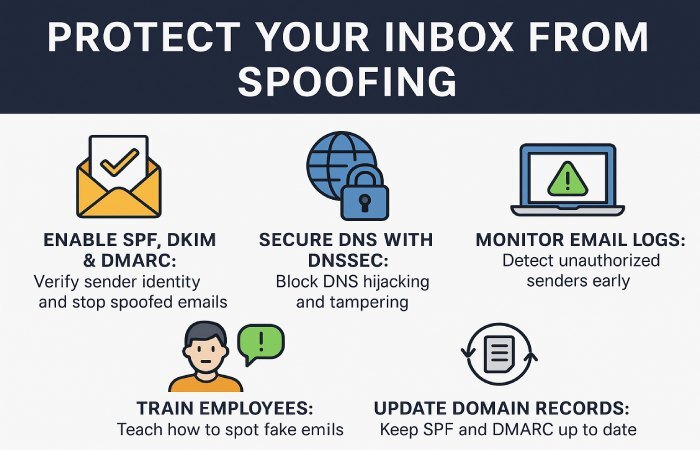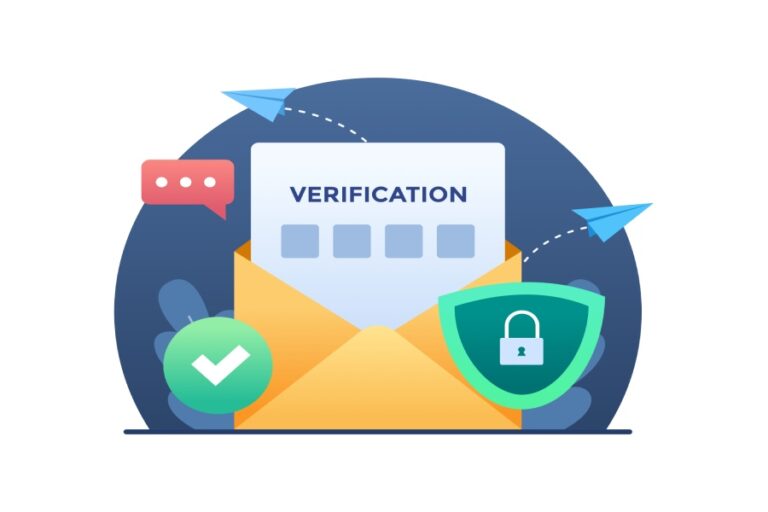Imagine typing a familiar website address into your browser, only to end up on a malicious page that looks exactly like the original. This scenario results from DNS spoofing, a deceptive technique that manipulates the Domain Name System to misdirect users or intercept communications. It is one of the many ways attackers exploit weaknesses in the Internet’s trust model.
At the same time, organizations often rely on email authentication protocols like SPF (Sender Policy Framework) to verify legitimate senders and block phishing attempts. Because SPF relies on DNS records, many assume it can also defend against DNS-based attacks.
But can SPF actually stop DNS spoofing? The answer requires understanding how both systems operate and where their security boundaries lie. This blog explains how SPF works, how DNS spoofing occurs, and the measures needed to protect your domain from both phishing and DNS-level tampering.

Understanding DNS spoofing and its impact
DNS spoofing, also known as DNS poisoning, happens when attackers manipulate DNS data to send users to fake or harmful websites. They do this by injecting false DNS records or tampering with DNS servers and caches so that a trusted domain name points to an attacker-controlled IP address. The end goal is often to steal credentials, spread malware, or hijack traffic for fraudulent activity.
What makes it dangerous is how quietly it works. Users think they’re on a legitimate website, but they’re actually communicating with a cloned one. The consequences can be severe, including phishing attempts, stolen credentials, malware infections, and long-term brand damage. Once users start losing trust in your domain or website, it becomes harder to recover both reputation and security posture. Detecting and resolving DNS spoofing quickly is crucial to preventing larger compromises.

How SPF works in email authentication
Sender Policy Framework (SPF) is an email authentication protocol that helps mail servers verify whether an incoming message was sent from an authorized source. Its main purpose is to detect and block emails that pretend to come from a trusted domain but actually originate from unauthorized servers.
An SPF record is a type of DNS TXT record published by the domain owner. This record contains a list of IP addresses or hostnames that are approved to send emails on behalf of the domain. When a domain publishes its SPF record, it tells receiving mail servers which senders are legitimate and which should be rejected or flagged.

Here’s how SPF validation works in practice:
- A mail server receives an email claiming to be from a certain domain.
- The receiving server extracts the sender domain from the “Return-Path” header.
- It queries the DNS to locate the SPF record associated with that domain.
- The IP address of the sending server is then compared against the list of authorized senders defined in the SPF record.
- Based on this match, the receiving server marks the message as a pass, fail, softfail, or neutral.
SPF primarily protects against spoofed sender addresses by confirming that an email originates from an approved mail source. However, it does not prevent DNS manipulation or spoofing at the network level. SPF’s security depends on the integrity of DNS itself, meaning if DNS data is compromised, SPF alone cannot ensure protection against DNS-based attacks.

Can SPF really stop DNS spoofing?
The short answer is no, SPF cannot stop DNS spoofing. These two operate on different layers of the communication system and protect against entirely different threats. SPF focuses on verifying the legitimacy of email senders, while DNS spoofing targets the network layer that translates domain names into IP addresses.
SPF depends on DNS to locate and read the sender’s SPF record. When a receiving mail server performs an SPF check, it queries DNS to verify if the sender’s IP is authorized. If the DNS response itself is compromised, the SPF result can be manipulated. This means that SPF is only as secure as the DNS infrastructure it relies on.

In a DNS spoofing attack, attackers tamper with DNS lookups, redirecting users or systems to fake IP addresses. This type of attack affects websites, online services, and name resolution systems, not just email authentication. Even though SPF strengthens email authenticity and reduces spoofed “From” addresses, it cannot detect or block DNS-level manipulation.
If DNS security is weak, attackers can use spoofed DNS responses to trick mail servers into retrieving falsified SPF data. Without proper safeguards like DNSSEC (Domain Name System Security Extensions), there is no reliable way to verify whether the DNS data used in SPF checks is genuine. Therefore, SPF is an important part of email security, but preventing DNS spoofing requires securing DNS itself through DNSSEC and continuous monitoring.
Strengthening protection beyond SPF
Since SPF has a limited role to play in preventing DNS spoofing, here is what you can do in addition to it:
1. Use DNSSEC to protect against DNS spoofing
DNSSEC (Domain Name System Security Extensions) adds a digital signature to DNS data, ensuring that the information received during a DNS query is authentic. It prevents attackers from altering or forging DNS responses. Enabling DNSSEC helps protect users and mail servers from being redirected to malicious destinations controlled by attackers.
2. Combine SPF with DKIM and DMARC
While SPF verifies sending servers, DKIM adds a cryptographic signature to confirm that the email content has not been changed in transit. DMARC builds on both SPF and DKIM to enforce domain policies and prevent spoofed emails from reaching inboxes. Using all three creates a strong, layered authentication system.

3. Adopt secure DNS management practices
Maintain DNS hygiene by using reputable DNS providers with built-in security controls and redundancy. Regularly monitor DNS traffic for unauthorized changes, adjust TTL (Time-to-Live) values to reduce caching issues, and restrict access to DNS configuration settings. Proper DNS management helps detect suspicious activity early and limits the impact of attacks.
4. Check SPF records regularly
Review and validate your SPF records using syntax checking tools to avoid misconfigurations. Remove outdated IPs or third-party senders that no longer require access. Keeping SPF records accurate ensures mail servers can verify legitimate sources efficiently without introducing vulnerabilities.

Final words
SPF plays a crucial role in verifying legitimate email senders and reducing spoofing, but its protection ends at the email layer. It cannot stop DNS spoofing because that threat targets the DNS infrastructure itself. To defend against DNS-level attacks, organizations need stronger measures like DNSSEC, continuous DNS monitoring, and strict management of DNS records.
By combining SPF, DKIM, and DMARC with secure DNS practices, businesses can build a multi-layered defense that protects both email and domain integrity. The result is a safer, more trustworthy digital identity that strengthens communication and preserves user confidence.






